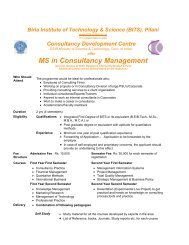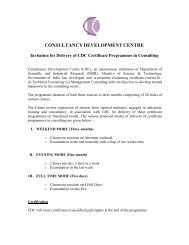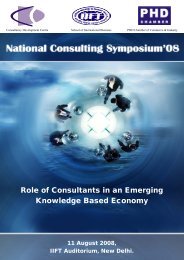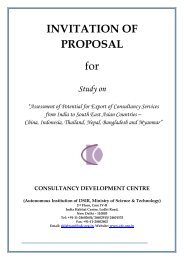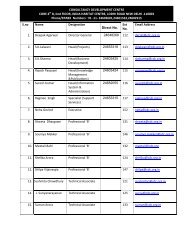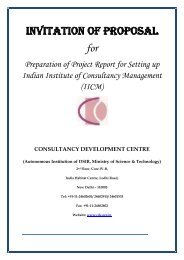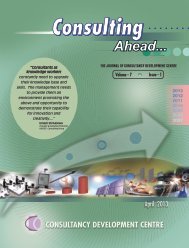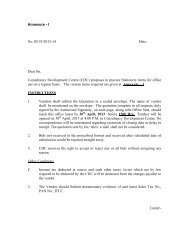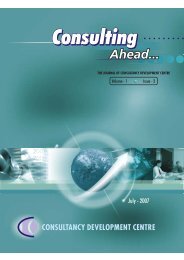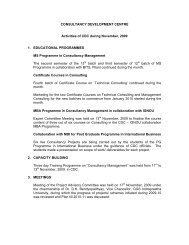Journal - January - 2010.cdr - Consultancy Development Centre
Journal - January - 2010.cdr - Consultancy Development Centre
Journal - January - 2010.cdr - Consultancy Development Centre
You also want an ePaper? Increase the reach of your titles
YUMPU automatically turns print PDFs into web optimized ePapers that Google loves.
Volume - 4 Issue - 1<strong>January</strong> - 2010
ISSN 0973-8312Consulting AheadVol. 4 Issue 1 <strong>January</strong> 2010Editor In-ChiefDr. Sunil AbrolEditorRajesh ParpyaniExecutive EditorJ. SuriyanarayananPublished by<strong>Consultancy</strong> <strong>Development</strong> <strong>Centre</strong> (CDC)Core IV B, 2nd Floor,India Habitat <strong>Centre</strong>, Lodhi Road,New Delhi-110003, INDIAAnnual Subscription for each Volume of TwoIssues is as follows:CDCMembersGeneralOverseasSubscriptionCategoryInstitutions & CorporatesIndividualsEducational Institutes in IndiaAcademicians & StudentsAnnualSubscription(2 Issues)Rs. 300/-Rs. 200/-Rs. 300/-Rs. 200/-Institutions & Corporates Rs. 400/-Individuals Rs. 300/-Institutions & Corporates US $50IndividualsUS $35Price per copy Rs. 200/-Consulting Ahead is a bi-annual in-house journalof <strong>Consultancy</strong> <strong>Development</strong> <strong>Centre</strong>, New Delhi.All editorial correspondence and articles forpublication should be addressed to the Editor -Consulting Ahead, <strong>Consultancy</strong> <strong>Development</strong><strong>Centre</strong>, Core IV B, 2nd Floor, India Habitat <strong>Centre</strong>,Lodhi Road, New Delhi - 110003, India.Articles submitted for publication are screenedby the editor and the executive editor forrelevance. Once the article is passed inpreliminary screening, it is sent for blind peerreview. Authors are requested to consult the“Author Guidelines” before submitting theirarticles.Views expressed in the articles in this journal arethose of the respective authors. Neither<strong>Consultancy</strong> <strong>Development</strong> <strong>Centre</strong> can accept anyresponsibility, nor does it necessarily agree withthe views expressed in the articles. All copyrightsare respected.Unless authorised no part of the materialpublished in Consulting Ahead may bereproduced, or stored in retrieval systems, or usedfor commercial or other purposes. All rightsreserved.Editorial and Administrative Address :<strong>Consultancy</strong> <strong>Development</strong> <strong>Centre</strong>Core IV B, India Habitat <strong>Centre</strong>Lodhi Road, New Delhi-110003, IndiaTelephone : (91- 11) 24602915 / 1533 / 2601Fax : (91-11) 24602602E-mail : consultingahead@cdc.org.inWebsite : www.cdc.org.inDesigned & Produced by: Maansee Printers : maanseeprinters@yahoo.co.in # 9810125541
CONTENTSIndian Consulting Sector and GATSDr C.S. Venkata Ratnam & Srinivas KolluruManagement Innovation – Role of a ConsultantRamesh S. TyagiHyper Targeting – An Information-based Process for Business OpportunitiesTim PowellSustain Thought-Filled PracticeDan CoughlinConsulting in Management – An Emergent Career Option for WomenDr (Ms) Mamta Mohapatra & Dr Bhupen SrivastavaThe Importance of Knowledge Transfer for Talent Management in aProgressive OrganisationVishal MohalGlobalisation and Quality of Management Education in IndiaDr V. Tulasi Das & Dr. P. Hanumant RaoTen Guiding Principles for Management Consultants for E-governmentDr D.C. MisraComparative study of 2D and 3D numerical analysis of deep excavation problemDr Sivakumar Babu & Amit SrivastavaIntelligent and Sustainable BuildingsA.K. Saini & S. ChaturvediRetrofitting – Going Green by Reducing ReconstructionRajendra Desai & Rupal DesaiBook ReviewsAuthor Profile119273340526370809197102115
Prof. B. BhattacharyaVice ChairmanInstitute for Integrated Learning in ManagementGreater NoidaMr S. S. ChakrabortyManaging DirectorConsulting Engineering Services (India) Pvt. Ltd.New DelhiMr Rajiv KhuranaManagement Consultant &ChairmanIMCI - Delhi ChapterNew DelhiDr Aneeta MadhokChairpersonThe International Council of ManagementConsulting Institutes (ICMCI)MumbaiMr Navyug MohnotManaging DirectorQAI (India) LimitedNew DelhiMr N. S. RajanPartner (Human Capital)Ernst & Young Pvt. Ltd.New DelhiMr G. ShankarPresident, Madras <strong>Consultancy</strong> GroupFormerly Vice Chair, ICMCI &Formerly President, IMCIChennaiDr George L. SmithProfessor Emeritus &Former Chair-Industrial Systems Engg.The Ohio State University (U.S.A.)Editorial Advisory BoardChairmanProf. C.S. Venkata RatnamDirector, International Management InstituteNew DelhiMembersMr Tanmoy ChakrabartyVice President & HeadGlobal Govt. Industry GroupTata <strong>Consultancy</strong> Services,New DelhiMr Brian IngFormerly ChairmanThe International Council of ManagementConsulting Institutes (ICMCI)Cambridge (U.K.)Mr Arun KochharFormer DGM (Corporate Affairs)Engineers India LimitedNew DelhiDr Bhimaraya A. MetriProfessor (Operations Management)Management <strong>Development</strong> InstituteGurgaonDr Kiran Kumar MomayaProfessor, Strategic / Technology Managementand CompetitivenessS. J. Mehta School of ManagementIndian Institute of Technology BombayMumbaiMr S. R. RaoPresident, Global ProcurementConsultants Ltd. & FormerlyExecutive Director, EXIM BankMumbaiProf. P. B. SharmaVice-ChancellorDelhi Technological UniversityDelhiDr Thomas C. TuttlePresidentWorld Academy of Productivity Science (U.S.A.)CONSULTING AHEAD - VOL. 4 - ISSUE 1
Indian Consulting Sector and General Agreement onTrade in Services (GATS)The paper presents an overview of global trade in services with specialreference to consulting services. It analyses the constraints in select sectorsin consulting and offers policy recommendations to strengthen the domesticcapacity to augment India's share. It is believed that India has comparativeadvantage in the supply of technical manpower at low cost, which needs toupgrade in global trade in consulting services.C. S. Venkata RatnamSrinivas KolluruCONSULTING AHEAD - VOL. 4 - ISSUE 1 1
Management Innovation-Role of a Consultant'Innovation is the specific instrument of entrepreneurship. It is the act thatendows resources with a new capacity to create wealth. Innovation, indeed,creates a resource. There is no such thing as a 'resource' until man finds a usefor something in nature and then endows it with economic value. Until then,every plant is a weed and every mineral just another rock.'(Peter F. Drucker, Innovation and Entrepreneurship,1985)Companies achieve competitive advantage through acts of innovation. Theyapproach innovation in the broadest sense including both new technologiesand new ways of doing things.(Porter, 1990)'Everyone knows that innovation is a core business necessity. Companies thatdo not innovate, die. This is not news.'(Henry Chesbrough, open business models,Harvard business school press 2006)Ramesh S. TyagiCONSULTING AHEAD - VOL. 4 - ISSUE 1 19
Hyper-Targeting: An Information-based Process forIdentifying Business OpportunitiesThis article presents several cases from the author's professionalexperiences that illustrate some basic principles of business development forconsultants. The cases are drawn from large, medium, and smallconsultancies. The author advocates client-centric business development,where the emphasis is less on “selling a service” and more on delivering atailored solution to a client problem. The key is knowing where and how tofind information about the client's situation and potential service needs.Ways to identify these problems early in the need cycle, even before theybecome competitive Requests for Proposal, are explored. Finally, a formal,phased business development process called “hyper-targeting” is describedin some detail, including a description of a live pilot test of itsimplementation.Tim PowellCONSULTING AHEAD - VOL. 4 - ISSUE 1 27
Sustain Thought - Filled PracticeThe Secret to Great Management PerformanceThe absolute key to great performance can be summarised in three words:sustain thought-filled practice. Dr. Anders Ericsson, professor ofpsychology at Florida State University, calls this “deliberate practice,” but Iprefer “thought-filled practice” because it involves doing a simulation of theactual performance while surrounding that action with thinking.This article examines in depth the six steps of thought-filled practice andspecifically how they apply to the role of a business manager in the areas oftalent management, leadership, strategy, planning, and execution.Dan CoughlinThe Six Steps of Thought-Filled Practice1. Select the role you have passion and strengths for doing.2. Clarify the five critical aspects of that role.3. Create simulations of the actual performance that allow you to focus onimproving one or more of the role's critical aspects.4. Gain relevant feedback from a skilled observer on the simulatedperformance in a timely manner.5. Consider the feedback and make adjustments.6. Repeat steps three to five for 10,000 hours.The practical, user-friendly approach in this article can be applied bymanagers in all industries to generate a sustainable improvement in theirperformance and results.CONSULTING AHEAD - VOL. 4 - ISSUE 1 33
Consulting in Management : An EmergentCareer Option for WomenEconomic development has opened up new vistas of career opportunities forIndian women. This paper studies in depth, the nuances of women taking upmanagement consultancy as one of the career options. Further more, itsurveys the types, sector and areas of consultancy undertaken by women andexamines the suitability and attractiveness of consultancy as a career option,the prospective sectors of growth and development of women consultancy asalso the competencies required. The authors have used the data collected bythem for a study titled "Status of Women Consultants in India"*** thataddresses a wide range of issues concerning women consultants in thecountry. The study surveys 161 women consultants and 46 aspiringconsultants located in four major cities of India having high concentration ofconsultancy organisations, The findings suggest that career and opportunityrelated reasons are the major attracting factors for making choice in favourof consultancy as a profession followed by growing opportunities in the fielddue to high growth of economy, increasing role of service sector and thedemands on organisation to meet global standards of performance in quality,cost, innovation and other parameters. The authors, in conclusion, suggestmeasures for promotion of women professionals in management consultancyas a career choice.Keywords : women consultants, consultancy effectiveness, careeropportunity.Dr. Mamta MohapatraDr. Bhupen Srivastava40 CONSULTING AHEAD - VOL. 4 - ISSUE 1
The Importance of Knowledge Transfer for Talent Managementin a Progressive OrganisationIn today's empowered and informed economy, organisations have systems inplace for implementing various talent management strategies to hold acompetitive advantage. However these organisations still face thechallenges in managing human capital.Talent Management is not just retention of high potential employees but, ithas emerged that the engagement of the entire organisation is equallyimportant for the overall strengthening of an organisation. To succeed intoday's competitive scenarios, companies need to deploy a well-groomedtalent stratagem, focusing on areas that may not have been considered underthe purview of talent management before.One such area is Knowledge Management, which helps organisations build asustained talent advantage. This paper brings out how KnowledgeManagement initiatives facilitate effective Talent Management within anorganisation.Based on the classification of Talent Management processes, a model toestablish the links between these processes and knowledge management isdeveloped. This model may help consultants to redevelop the talentmanagement model with their client organisations.Vishal Mohal52 CONSULTING AHEAD - VOL. 4 - ISSUE 1
Comparative Study of 2D and 3D Numerical Analysisof Deep Excavation ProblemThe results of 2D and 3D numerical analysis for a deep excavation problemin soft clay are compared and discussed. In the study, commercially availablefinite element code PLAXIS is utilised and finite element calculations aredone with two standard constitutive material models, i.e., (i) Mohr-Coulomband (ii) Hardening Soil model, an isotropic double hardening model, asimplemented in the commercial version of the finite element code. It is notedthat, for a given constitutive material behaviour, 2D numerical analysisresults, when compared to results of the 3D numerical analysis, over predictsthe deformation and under predicts the stability, the later is evaluated interms of factor of safety using strength reduction technique. The deformationvalue obtained using Mohr-Coulomb model is lower than the correspondingvalue obtained from strain hardening model.Key words : deep excavation, finite element, Mohr-Coulomb, strainsoftening, deformation, factor of safety.Dr. Sivakumar BabuAmit Srivastava80 CONSULTING AHEAD - VOL. 4 - ISSUE 1
Intelligent and Sustainable BuildingsThe construction sector is a major user of construction materials andprocesses that have impact on the health and safety of both workersand the people who live or work in buildings. The quality ofbuildings has a direct influence on the quality of life. From anenvironmental perspective, construction is both a hugeconsumer ofnatural resources and a generator of large amount of waste andpollution. In addition, buildings are significant users of energy, withits indirect relation to emission of greenhouse gases.The modern living has necessitated integration of all latesttechnologies in a building design for maximum consumersatisfaction in pollution free environment leading to the concept ofintelligent buildingsThe intelligent buildings with focus fromcomfort to users will require huge consumption of energy andresources. In order to minimize not only consumption of energy butalso to the usage of natural resources, concept of sustainablebuildings developed. The sustainable buildings should be energyefficient and integrate the latest information and communicationtechnologies.Standards play key role for the energy efficient, eco-friendly and costeffective that is sustainable development of infrastructure. Standardsapplicable to todays buildings increase production efficiency,optimize resources disseminateknowledgeandsimplifythedesignandplanningofbuildingsA.K. Saini & S. ChaturvediCONSULTING AHEAD - VOL. 4 - ISSUE 1 91
Retrofitting – Going Green by Reducing ReconstructionGreen options are discussed when one is planning to build a new building orone is trying to improve the energy efficiency of the existing building. Butlittle is given to green option when one is aiming to reduce the vulnerability ofthe people in the face of a disaster. In the post disaster situation tens ofthousands of buildings are severely damaged or destroyed and they arerebuilt, generally, using modern technologies having high carbon foot print.Lots of vulnerable load-bearing masonry public buildings are summarilyabandoned and replaced with new safer building of RCC having a largecarbon footprint. But such buildings that are still standing could be easilymade safer with retrofitting having a very small carbon footprint.Today it has also been observed that in the name of safety against futuredisasters, people in the disaster prone areas are also demolishing theirperfectly good traditional buildings that are truly green. They are beingreplaced with buildings that have a much larger carbon footprint. Thesetraditional buildings in various areas of the country can easily be made saferthrough retrofitting them.Unfortunately, architects and engineers know little to nothing of loadbearingmasonry buildings or the traditional buildings. These buildings aregenerally green. Instead they recommend the use of RC construction, even incase of single storey construction. In India we have a large number of greentechnologies that are traditional. It is important that we use them rather thanabandon them and search for their alternatives.Rajendra DesaiRupal DesaiCONSULTING AHEAD - VOL. 4 - ISSUE 1 97
BooReviewTitle : Hit the Ground Running: A Manual for New Leaders(Portfolio 2009, New York)Author : Jason JenningsPublisher : Portfolio (Hardcover)Reviewer : Dan CoughlinJason Jennings has a rare gift. He has the energy toclimb the massive mountain of research necessary toreally understand a big issue and the patience tocome down from the peak and explain what he haslearned in practical ways that readers can useimmediately.Hit the Ground Running is a perfect example of thisgift. He wanted to find out what really, reallystsuccessful 21 Century business leaders do in theirfirst year on the job that makes for sustainable andprofitable success. He and his research team took thelargest thousand publicly traded companies in theUnited States, examined the performance of thosecompanies from 2001 through 2007, and narrowedthe list to nine companies through a series ofextremely stringent filters. He then interviewedextensively the CEOs of those nine companies.And why is all of this work of value to the reader?Jennings captures a host of practical insights fromeach of the CEOs and presents them in a usable formthat leaders can use at any time in their career. It'slike having a massive toolbox with the very bestproven management tools available inside it.Readers can open up the toolbox, pull the tools out,and then decide which tool is most appropriate for agiven situation.Here are some examples that I loved:Tim and Richard Smucker, CEOs of The J.M.Smucker Company, talking about theimportance of publicizing their organisation'sstrategy. Rather than keeping their corporatestrategy a secret they want as many people aspossible to know the strategy. That wayeveryone in the company knows the strategy,and, just as importantly, everyone knows thateveryone else knows the strategy. That's how astrategy effectively guides long-termdecision-making in a consistent manneracross the board. If you have a secret strategy,then managers can claim ignorance when theymake a decision that doesn't support theorganisation's strategy at all. Develop a clearstrategy, make it known to everyone inside andoutside the company, and then follow thatstrategy. That's good advice.Fred Eppinger, CEO of The Hanover Group,which is a property and casualty insurancecompany, getting his company real andkeeping it real. He took all of the fancyfurniture out of his office on day one andreplaced it with a whiteboard and a conferencetable. He wanted to make it clear that his spacewas about collaborating and working. He wentand talked with people throughout thecompany and at all levels. He met with allthree thousand employees in group sizes offifty or fewer. He wanted to know the realstory. He divested the company of a widerange of businesses and got everyone focusedon building a world-class property andcasualty insurance company. Ron Sargent,CEO of Staples, Inc., demonstrated this samemaniacal focus on getting his massive102 CONSULTING AHEAD - VOL. 4 - ISSUE 1
Book Reviewcompany to focus on the core business whenhe eliminated eight hundred items in hisstores. He wanted to go from having a lot ofitems to having the right items in each store.Howard Lance, CEO of Harris Corporation,along with Mike McCallister, CEO ofHumana, Inc., Patrick Hassey, CEO ofAllegheny Technologies, and MarshallLarsen, CEO of Goodrich, Inc., demonstratingthe importance of asking for help. They allopenly admitted that they weren't shy aboutsaying they didn't have all the answers andoftentimes asked former CEOs at theircompanies, board members, other officers,and employees for advice on what to do.Rather than pretending they were perfect, theyhit the ground running by asking a lot ofquestions and listening to a lot of opinions.Patrick Hassey explaining that commoditiesare only commodities if they are exactly likewhat the competition offers. He makes a greatpoint, which is really supported by all of theother CEOs, when he talks about the key tosuccess for an organisation is to find out whatit can do incredibly well. For Hassey atAllegheny Technologies it was “offering asteady stream of alloys and products neededby our customers, stellar service, geopoliticalstability, and the best engineering in thebusiness.” At Staples it was having the rightstock at the right time for the right customersserviced by the right people. Great leaders findways to differentiate their organisations bystrategically combining strengths to createuniquely great value for their customers.Jeff Lorberbaum, CEO of Mohawk Industries,talking about his company's relentless focuson simplicity, speed, and efficiency. Actually,these three words describe the behaviors of theCEOs highlighted in this book. Each of themclarified exactly what to do in the first ninetydays and then moved with speed andefficiency. There are no examples ofcomplicated, convoluted strategizing sessionsthat went on and on for months and months.Instead each person identified what could bedone to make a real difference and then wentand did it.Strengths of the book:Three words: research, stories, and pragmatism.At the end of the book you will read the incredibleprocess that Jennings and his research team used tonarrow their list to nine companies. The interviewsin this book were not randomly selected or chosenbased on which CEOs signed up first. Instead theseCEOs were very, very carefully selected. Thatmakes their stories so much more valuable for thereader.Even though this is a practical management book, itreads with the speed of a series of short mysterynovels. I became immediately enthralled with thecharacters in each story and the ways in which theyused their first three months, six months, and year toaccelerate their organisation's performance levels. Ifound myself asking, “What's next, what's next?”the same way I do when I read a book by JamesPatterson or Sidney Sheldon.However, these weren't fictional stories. Theyactually happened. This isn't a theoreticalmanagement book. It is absolutely rooted in realstories with real practical advice that can be appliedimmediately. I absolutely loved the pragmaticnature of this book. I was also really taken by thetypes of people described in these stories. Thesesuper-successful CEOs are down-to-earth, humble,caring, and genuine folks who want to see otherpeople succeed. These real-life stories make it clearthat any leader can be successful if he or she iswilling to step up and do the essentials necessary toguide the organisation to significant and sustainableresults.What would have made this book better?I think the subtitle is a little misleading. Rather thanbeing “A Manual for New Leaders” I think it shouldCONSULTING AHEAD - VOL. 4 - ISSUE 1 103
Book Reviewbe “A Manual for Leaders Who Aspire forGreatness.” I have a hard time thinking of anyexecutive or manager regardless of their tenure witha group in any size organisation whether it's forprofitor not-for-profit who would not benefittremendously from reading this book. It is thatpowerful.The insights, quotes, and proven behaviors areincredibly valuable. One thing that might have madethe book better is if Jennings had recommendedspecific tools for a leader to use in his or her firstforty-five days, the next forty-five days, and so onthroughout the course of the first year in a newposition. The reader obviously would not have tofollow the recommendations in a literal sense, but itmay have been a way to help the reader organize thewide array of tips and tools in this book. This book iswritten without use of much jargon in a suave andsavvy manner. A book full of strategies andexamples to widen the horizon, a plan to think out ofthe box, an idea to be non conformist in thoughtwhile planning ahead. An approach , a plan ,aprocedure without a scheme or connivance of alimited approach. A blue print, a flight tounchartered territory, a proposal, a preposition toincrease your market boundaries. A sure winner, aneye opener and new method for all of us to think,strategise and succeed.Title : HR Transformation – Building Human Resources from the Outside InAuthors : Dave Ulrich, Justin Allen, Wayne Brockbank, Jon Younger & MarkNymanPublisher : TATA Mcgraw Hill, 2009Reviewer : Dr. Aneeta Madhok, Chairperson, International Council ofManagement, Consulting Institutes (ICMCI) & Director, OpenSpaces Consulting (P) Ltd.Often, managers dismiss the cognitive by saying“this is all theory – reality is very different!” Bookknowledge is discarded as being impractical andlessons that are taught at business school are oftenrequired to be unlearned before the youngmanagement trainee is deemed to be a productiveresource. This time, all the 'practical pundits' will beproved wrong because here is theory that is derivedfrom practical operating knowledge and wisdom.CEO's who felt that HR was missing something, willnow come nearer to closing the gaps between realityand rhetoric and the best part is that it is not a rocketscience.We all know that people are at the core of anybusiness organisation. The dream of every CEO andHR Manager is to have a completely synchronousorganisation with perfect and seamless alignmentbetween business context, outcomes, HR redesignand HR accountability for totally optimized peopleperformance. The book provides one such seamlessmodel complete with toolkit for HR transformation,online resources like videos and downloads, casestudies that prove it can be done in the real world,and endorsements from across the globe, includingIndia, and a complete watertight case on how theseformulas can work for you.Nothing is superfluous in this feast for the grey cells.The authors present a case for transforming the HRfunction taking the cues from the business context inwhich the company exists. Pitfalls that preventsuccess have been identified and HR Managers areurged to put rationale before action, integrate andalign HR strategy with business strategy, undertakeholistic efforts and not piecemeal partial ones, and104 CONSULTING AHEAD - VOL. 4 - ISSUE 1
Book Reviewconnect to all parts of the organisation and not be anindividual champion. Don't fall into the trap that thesolution lies in another HR structure, and efficiencyequals transformation because these derail, crippleand infect the process of transformation that is soneeded within the HR function.Simplicity leads to success. So HR Managers needto build the business case, define the outcomesexpected, redesign HR and engage line managersand others and a completely new leaf is turned overand HR is renewed, remodeled and revitalised intheir relevance to business and work. But beforeanything else, you need to answer serious questionson 'why' you need to change. Once you areconvinced that you are at the right level of readinessfor change, you can enter the hallowed portals ofthose that can succeed at the transformationalefforts. If you fail the assessment, then you stay atsquare one and take time off to understand yougeneral business conditions and specificstakeholder expectations. You can keep yourselfintact because the reasons are all out there and thetransformation is not inside you.The new performance indicators for the HR functionare the extent of satisfaction of stakeholder concernsand the capability of the organisation that got built inthe process. There are many practical suggestionsthat can give concrete measures for varioussegments of stakeholders like employees, leaders,customers, regulators, analysts/investors, and thecommunity. HR is also expected to contribute toenhanced measures of organisational capabilitiesthat define the fundamental identity, culture andimage of the company.Redesigning HR is very easily explained by theauthors. All you need to do is to re-calibrate who youare, what you deliver, and why you do it? There is noexistential angst as all it takes is to fill in the blanksthat define the answers to these questions and yourHR strategy statement is ready. The HR organisationis ready for transforming as all it has to do is to makethe HR department follow the logic and structure ofthe business organisation and be just like any otherprofessional service organisation and make adifference between transactional HR andtransformational HR work. This will set thefoundation for clear changes in the five channelsthrough which HR delivers value. A tweak of theresponsibilities of these five channels of delivery isall it takes to finalize the HR departmenttransformation.HR is transformed through content and processinterventions. Redefining the content of HR aspeople, performance, communication, work andinfusing processes of alignment, integration andinnovation will create a road map for enhancing HRpractices. But this is only the blueprint. The realeffects of transformation are undertaken byupgrading the HR professionals to the currentbenchmarked wavelengths by setting the standards,assessing individuals, investment in talentimprovement and following up and trackingcompetence.It doesn't work until you hold HR accountable forachieving its own transformation by involving HRleaders and professionals, line managers, externalcustomers and investors, and consultants andadvisers. It all happens when you make it happen bydefining milestones, activities and outcomes and byturning what should happen into what does happen.To make the HR transformation irreversible meanstaking the necessary steps towards institutionalizing.As a special icing on the cake, the four case studiespaint a wonderful picture of HR transformation.Flextronics was one where the company created anHR organisation from scratch, Pfizer achievedtransformation of a large established system, Intelmoved their HR from tactical to strategic, andTakeda where HR demonstrated its value-add in asmall nimble subsidiary.The book is clear of clutter and excessive jargon,very well structured information and appeals to theleft brain of intelligent readers. Target audienceswould include HR consultants who specialize inenabling HR processes, CEO's who want more outof their HR, HR professionals themselves and alsoCONSULTING AHEAD - VOL. 4 - ISSUE 1 105
Book Reviewanybody interested in simple solutions for problemsthat are often very complicated.In reality though, HR effectiveness is not sostraightforward. Its easy to escape into strategicthinking but there are many operational and tacticaldeliverables that ought not to be ignored. Strategicexcellence is always meant to be built overoperational excellence. Employees have their firstand last encounters in organisations through the HRdepartment and moments of truth are experiencedrealities in those encounters. Things are as they 'are'and not as they 'ought' to be and HR always pays theprice for the glass being half empty rather than halffull. Eventually it's the spirit of HR and not thecontent and process that makes the difference andthose who know these things know the difference itmakes. And the spirit comes from inside-out andnot outside-in. The real transformations are insideheads, hearts and minds of people who live andexperience organisations every day.Title : It's Not What You Sell, It's What You Stand For : Why EveryExtraordinary Business is Driven by PurposeAuthors : Roy Spence & Haley RushingPublisher : Portfolio, 2009Reviewer : Dan CoughlinValue for the reader:I consider this book to be a foundationalmanagement book. By that, I mean every executiveand manager should read this book to improve his orher ability to build a foundation for the long-termsuccess of the organisation. The essential messageof this book is that a clearly defined and articulatedpurpose that employees and customers will trulyrally around is the starting point of a greatorganisation. When the purpose is taken seriously, itcan guide an organisation through good and badeconomic times to long-term success.More than any other book I've read, this book clarifiesthe long-term importance for an organisation to havea compelling reason for existing and to use thatpurpose to guide operations, marketing, talentmanagement, customer selection, and investmentdecisions. I believe readers will walk away with aheightened sense of urgency to clarify thecompelling reason for their organisation's existenceand a set of practical exercises to accomplish thatobjective.Readers will also gain a roadmap for using thispurpose to guide decisions within each of theorganisation's individual functions and departmentsin ways that will create a vastly more effective andmore synergistic approach to the marketplace. In theend, I believe that continually leveraging anorganisation's purpose leads to significant andsustainable improvement in its most importantdesired outcomes, and that this book is valuableresource to help make that happen.Strengths of the book:I felt this book had two primary strengths: structureand examples.The first half of the book guides the reader through aseries of practical steps to accomplish the following:understand why having a purpose is so important,determine how to discover the purpose of theorganisation, establish ways to communicate thatpurpose to the marketplace, build an organisationaround the purpose, and provide leadership tocontinually keep the purpose at the center of alldecision-making in the organisation.The second half of the book provides a series of reallifeexamples on discovering and leveraging anorganisation's purpose from Southwest Airlines,106 CONSULTING AHEAD - VOL. 4 - ISSUE 1
Book ReviewBMW, the PGA Tour, the American LegacyFoundation, the American Red Cross, Wal-Mart,Norwegian Cruise Line, AARP, Texas A&M, andthe American Council for Education. The reasonwhy these examples were so useful is because theauthors have worked with all of these organisationsto help them discover and articulate their purposein ways that have generated extraordinary results.In reading these examples, the suggestions from thefirst half of the book seemed much more realisticand meaningful. In seeing how other companieshave used the approaches to discover and articulatea compelling purpose helps the reader see the stepsthat he or she can reasonably take to accomplishsimilar objectives. It becomes very clear that theideas on purpose are universal and can be applied toany type of organisation.What would have made this book better?The authors did a fine job of explaining the beforeand after scenarios of the organisations they'veworked with in terms of the impact that clarifying apurpose has on an organisation's results.What would have been a great feature is if they couldhave done a comparison between an organisationthat marches forward with a clear purpose and acompetitor that does not have a clear purpose forexistence. For example, a chapter comparing each ofthe past thirty years of performance betweenSouthwest Airlines and American Airlines mighthave highlighted even further the importance of aclear, consistent purpose guiding decisions over along period of time.Another feature that may have been of value toreaders is to chart a company's actual results for itsmost important desired outcomes year by year andthen show the years where its purpose for existencewas steadily becoming more clear. In doing so, itmay be possible to better quantify the actualbusiness impact of an intangible such as having aclear purpose for existence on the desired businessoutcomes.More information about the book:If you would like to learn more about this book,I encourage you to visit this website:www.itsnotwhatyousell.com. You will findopinions about the book from a variety of keyleaders and further explanation from the authors onwhy they wrote the book.Title : Simply Effective - How to cut through complexity in yourorganisation and get things doneAuthors : Ron AshkenasPublisher : Boston : Harvard Business Press, 2010Reviewer : Dr. J.K. Mitra, Professor of Strategy and Organisation Behavior,Faculty of Management Studies, University of DelhiIn this complex and unpredictable world, one of theprimary goals of any management process is tomake things understandable and predictable.However, in such pursuits of sheer efficiency, oftenmany 'simplistic' ideas are dished out that neitherexplains phenomena in any better way nor makethese controllable. Fortunately, this latest book byDr. Ashkenas, who currently consults to CEOs andsenior executives on organisation transformation asManaging Partner of Robert H Schaffer &Associates, do not fall in this genre. The authorintended to lay out a practical set of tools andstrategies for simplifying organisations, with afocus of getting rid of the complexity that managersgenerate themselves. This intention has beenachieved through a simple structure of the book andCONSULTING AHEAD - VOL. 4 - ISSUE 1 107
Book Reviewinclusion of diagnostic instruments, examples andcase studies from organisations that embarked onthe journey toward simplification.The book has seven chapters. The first chapterprovides a definition of simplicity and highlights itsimportance through illustrations of how combatingand curbing complexity can catapult an organisationto a new circuit of efficiency. Here he proposes amodel of four ways in which managersinadvertently create complexity in their workplaces:structure, products, processes and ownbehavior. The chapter concludes with a briefquestionnaire that helps readers diagnose which ofthese areas might be of most concern to them.The next four chapters explore and analyze eachsource of complexity. It also provides tell-tale signsof the source so that managers can recognize theseand avoid falling into the traps. In each of these fourchapters, the author has provided a tool-kit that isexpected to promote simplicity in that particular area.Chapter 2 deals with simplifying organisation'sstructure with a discussion on serious flaws inhierarchical simplicity. The author alerts us aboutthree common traps that lie in wait before managerswhen they approach designing an organisation: (i)refining structure before crafting a strategy; (ii)considering people and personalities beforeconsidering the strategic logic; and (iii) building amechanical rather than an organic structure that iscapable of reorganising in accord with businessneeds. To avoid these traps, four principles arerecommended to be followed: (a) differentiatebetween core and the context; (b) take a customerperspective; (c) consolidate similar functions andtasks; and (d) prune layers and broaden spans ofcontrol.Chapter 3 focuses on reducing product proliferation.The author surmises that product or servicecomplexity usually has one or more of the fourcauses: (i) volume complexity by adding number ofproducts or features in each product; (ii) supportcomplexity by failure to provide clear instructions ofhow to use products or get help when needed; (iii)system complexity by failing to integrate productswith customer's existing business; and (iv) designcomplexity or creating a product from sophisticateddesigner's perspective than that of a naïve user.Managers can use three structured approaches toovercome product-related complexities: (a) use ofportfolio analysis such as BCG Matrix or GEMatrix; (b) rationalization and reduction of stockkeepingunits; (c) co-creation or partnering withcustomers to design a product.Chapter 4 deals with the challenge of streamliningprocess complexity. Processes that evolve over timebecome complex in four ways: (i) local differencesduring implementation, (ii) multiplication of stepsand loops; (iii) lack of rigor and informality of theprocess; (iv) lack of cross-functional or cross-unittransparency. Five approaches have been suggestedfor process simplification: (a) best practiceidentification, sharing and comparing; (b) processmapping and redesign by making implicit processexplicit; (c) lean six sigma approach; (d) rapidresultsapproach for breaking logjams and engagingpeople swiftly; and (e) GE work-out approach ofcreating a culture of process simplification. Therelative advantage of each of these five approacheshas also been discussed.A very insightful Chapter 5 focuses on howmanagers contribute to complexity while theyprovide guidance, leadership and direction for anorganisation. Two natural human tendenciesoverdoingstrengths and avoiding areas ofdiscomfort - keep many managers firmly on thewrong track. The upsets are often createdunintentionally by many apparently innocuousbehaviours. For example, the quest for a 'perfectstrategy' may create enormous churn andcomplexity. This chapter carries a 22-item selfdiagnosticquestionnaire that can be used to reflecton one's own behavior regarding strategy planningand budgeting, goal-setting and demand making,and other unconscious communication behaviorsthat often breeds complexity in an organisation.The remaining two chapters move towardscombining the puzzle pieces to provide an108 CONSULTING AHEAD - VOL. 4 - ISSUE 1
Book Reviewintegrated strategy of combating complexity.Chapter 6 draws up a firm-wide or a SBU-widestrategy for simplification that can be used to drivebetter performance. The final chapter brings thefocus back to the reader - the practicing executive.As charity begins at home, simplicity starts withself. It is up to the reader - beginning with oneself - totake steps to make the workplace easier, simpler andmore productive.One of the main strengths of the book lies innumerous examples drawn from a large number oforganisations to illustrate the author's views andsuggested approaches in each of the chapters.Though most of the examples have been drawn fromprimarily two organisations - GE and its divisionssuch as GE Capital, GE Healthcare, GE Lighting,GE Money and ConAgra Foods - many otherexamples have also been drawn from CiscoSystems, Herman Miller, Northshore - LIJ Healthsystem, Pfizer, World Bank, Zurich FinancialServices and such others that simplify understandingof a complex subject.The overall message of the book is simple: Back toBasics. As the author writes in the conclusion of thepreface of the book, “Simplification is not the onlyanswer—but it's a good place to start” (p. xx).Title : The Management 500Author : Dan CoughlinPublisher : American Management AssociationReviewer : Walter E. Vieira, Management Consultant“The Management 500” by Dan Coughlin has beenpublished by the American ManagementAssociation in 2009. It is an interesting book of just230 pages, which goes through all the principles ofManagement by aligning them to the WinningPrinciples in Formula 1 car races. Obviously Dan ispassionate about auto racing. He is also passionateabout good management, and has been successful asa management consultant and key note speaker withclients like Toyota, Shell, McDonalds, Prudentialand many others.Dan has 'differentiated' himself by adopting a 'newapproach' to management performance. To look atbusiness management through the prism of autoracing. I am sure this can be done with most sports –like cricket, hockey and football. It is a good way toalign a 'hobby interest' to a 'study of business.' Butthe reader must not only be familiar with the sport,but also be passionate about it. Auto racing is not abig sport in many parts of the world. Europe andSouth America would have been more comfortablewith football (Soccer); and India, Australia, S Africaand United Kingdom with an alignment withcricket. But who knows? Dan might have started anew movement of publications, which alignfavourite sports with business management to makethe study and practice of business managementmore palatable, easier to understand and tocommunicate, to ensure more effective practice.For those who could not care too much about autoracing – some of the extensive details regardingauto-racing history seem tedious and tiresome. Inthe same way as some of the cricket statistics wouldseem tiresome to a non-cricket enthusiast.Management 500 says that to excel in the world ofauto-racing, a driver needs passion, shrewdness,quick thinking, strategy, team work, attention todetail, practice and dedication. And this is also trueof leaders in the business world.Dan again draws parallels of how to rev up yourskills in areas like leadership, teamwork, strategy,branding, problem solving, change managementand innovation, to get your company running in highCONSULTING AHEAD - VOL. 4 - ISSUE 1 109
Book Reviewgear. He tells you what racing drivers have to doquickly and also for the full race. And for businesshe gives the formula of what you should do in 30days and then in the 3 years. These time stipulationsare not always applicable. It is the time dimension ofan expert from the West. In the East, we haveconsiderably different time dimensions. It is a crossculturalissue!This is not to detract from the value of the bookwhich helps you to discover how touse pit stops wiselydevelop a team of people who understand yourgoalsdesign a winning strategybuild brand equitymanage your people through an understandingof their strengths, passions and valuessuccessfully navigate turns in the trackproblem solve on the go, even when things areintense.One of the sections I greatly liked is the 'Turns in theManagement 500 track” (Pg 210). The examplesfrom Turn 1 to Turn 16 were truly thoughtprovoking– and added great value to the book.Another significant contribution is Dan's subtle wayof brining 'ethics' into management with Sectionslike 'Ways to lose the pole position', 'Ways to crashand be eliminated from the race,' (pg 42/43) and keypartner promises (pg 51).'Speed up Brand Equity' is a particularly engagingchapter. Dan has covered a whole book on BrandEquity in just 23 pages. And done thatcomprehensively; and for me, fairly completely!He has followed his own principle, which was the'raison d'etre' for the book. To avoid process creepand embrace simplicity which will increase speed.A good feature of this book is the 'boxes' in everyChapter giving a summary of 'Processes' (just Pointsto Remember) e.g. pg 24 'The Process forUnderstanding your Industry'. Pg 37 'The Processfor Qualifying for the Pole Position as a BusinessManager.' I wish all these boxes were repeated againat the end – so Managers could tear them out of thebook and use them at their desks as ready referenceon the different aspects of Management. For thereader, it would have been the 'last lap'.Its an interesting book, easy to read, embracessimplicity, reinforces what others have already saidand as eternal management truths will always sufferfrom being 'oft repeated' – albeit with a differentscanner.'Title : The McKinsey Engagement - A Powerful Toolkit for moreefficientand Effective Team Problem SolvingAuthor : Dr. Paul FrigaPublisher : TATA Mcgraw Hill, 2009Reviewer : Mr. Rajiv KhuranaChairman - DelhiChapter, TheInstitute ofManagement Consultants of India IMCIBenjamin Franklin had said, "We must all hang itsowndifferentperspectiveandframeworkontogether, or assuredly, we shall all hang separately." teamthroughanacronymTEAMFOCUSTheThetogethernessinateamhasbeensaidin authorDrPaulNFrigastatesthatthedifferentwordsindifferentwaysatdifferent frameworkisnotusedinMcKinseybutthetimesbydifferentpeopleindifferentperspectiveconcepthehasdevelopedisconsistentwiththoseThisbook, "the Mckinsey Engagement"presents taught to the up-and-coming advisors to the top110 CONSULTING AHEAD - VOL. 4 - ISSUE 1
Book Reviewcorporations in the world at McKinsey andelsewhere.The first component covers four key elements of theinterpersonal interactions that affect projectmanagement and team problem solving;thusthekeyword TEAM. In its expanded form, it meansTalk, Evaluate, Assist and Motivate.The second component of the model relates to thecore analytical elements of successful projectmanagement. The key word FOCUS consists ofFrame, Organize, Collect, Understand andSynthesize.This is a guidebook for action. Each chapter builds The book is indeed worth the time and moneythe toolkit - toolbytoolThegoalistohaveall investment. An intriguing factor however is, "Whyteammembersreviewthecontentsbeforestarting is the book called McKinsey Engagement when asaproject, thendigdeeperintothechaptersover per the author the concept is not used or practiced inthecourseoftheprojectThebookcanalso beused in academic settings to teach team problemsolving, consulting or project management.The case study is the key aspect of the book. Theauthor admits to have lived through the conceptduring his career at PricewaterhouseCoopers andMcKinsey. HeusedtheconceptstotestinaliveengagementbystudentsworkingonaprobonoprojectTEAM FOCUS is an easy to remember acronymwhich is explained in detail over the course of thebook. While not every piece is novel, unique or pathbreaking, the authors approach is a good one. Bycoupling each piece of the model with first-handexperience, he shows the reader exactly how toimplement each step.This book is for someone that has a lot of teamprojects and is willing to try things differently. Mostteams have a midpoint transition in which the courseof their project changes. But, by following theframeworks in this book, teams are set up forsuccess right from the start.The reader will be suitably rewarded to learn: Clearrules of engagement, Set of operating tactics,Sophisticated problem solving tools, Easy-tofollowaction steps, Exercises, checklists, andtraining tips, War stories and best practices casestudies, A toolkit for bringing clarity, discipline, andpurpose to problem-solving and changemanagement initiatives.McKinsey?" Skipraisingyoureyebrows and youwill certainly benefit. After all, as John Scully said,"The future belongs to those who see possibilitiesbefore they become obvious." ThebookdoesunfoldpracticalpossibilitiesIn reality, Projects arenot identical in nature. Each project has a differentdesired objective. Therefore the project manager hasto be well versed on the tools rather than on thetechnical knowledge of the subject of the project. Ifthe tools are applied appropriately, the result of theproject will be as per expectation. Hence the bookwill be extremely useful to all whether familiar oralso for those who are not so familiar with theapplication of project management tools. Final oneline, this is a must for those who are aspiring to bean expert in project management and for those whowish to continue being an expert or an projectmanagement specialists in any industry ororganisation.CONSULTING AHEAD - VOL. 4 - ISSUE 1 111
Book ReviewTitle : Toyota Kata Managing People for improvements, adaptiveness,and superior resultsAuthor : Mike RotherPublisher : Tata McGraw HillReviewer : Ramesh S. Tyagi, B.E, F.I.E, CMC, FIMCIndustrialandManagement ConsultantToyota Kataby Mike Rother publishedbyTata CompanythatthrivesLongTerm The authorMcGraw-Hill isanaddition to a number ofbooks stresses that Toyota is different from otherwrittenonToyotamanufacturing and production manufacturing companies because it keeps adaptingmanagement systems. Some of thebookson Toyota and improving in quality and cost competitivenessinclude:TheToyotaWayJeffreyK liker The in a systematic and effective manner. ToyotasToyotaFieldBook DavidP Meier ToyotaTalent superior results spring more from routines ofJeffreyK LikerandDavidP Meier ToyotaSupply continuous improvements than from the tools andChainManagementAnanthVIyer Kanban practices that are visible. At Toyota theJust-in-time at Toyota: Management begins at the improvementoccursineveryprocessand at everyworkplace JapanManagementAssociation etc. level of the company every dayToyota Kataiscoveredinabout 300 pages and The second part knowyourself dealswith how wemakesaninterestingreadingwithillustrationsand are approaching improvements?Theconceptofexamples Thethemeofthebookessentiallyfocuses value-stream Mappingisexplainedindetailoncontinuous and robust process improvements Value-streamMappinglooksattheflowofand adaptation as a way of working at Toyota materials informationand the associated lead timeacross multiple processes and can reveal manyThe word kata comes from the Japanese meaningimprovement potentials. The author, based on hisformal exercise. Kata is a series of movements andobservation,mentions that action-item list is mosttechniques that are practiced in a pattern and has awidely used for process improvement. Action-itemdeeper and spiritual meaning that is done in almostlist is a listing of multiple improvement ideas andevery aspect of life. The author has used thisactions to be implemented at a process. The actionterminology to illustrate innovative managementitems on lists originate from recording processpractices at Toyota and mentions that kata is a wayproblems, problem solving activities, value-streamof keeping two things in alignment or synchronizationmapping etc. Problems and opportunities forwith one another Kataisdifferentfromproductionimprovements and action items are assignedtotechniquesinthattheypertainspecificallytothepeopleand a time frame is established.behaviourofpeopleandaremuchmore specificallyapplicable.The third part deals with the improvement KatahowToyota continuously improvesToyotafirmlybelievesthattoachievecompetitiveadvantageandlong– term organisational survival, The authorexplains how improvement kata can beapplied to ensure that people act for long rangeorganisational improvements and adaptation aresurvival of the organisation Toyotas improvementmore important as compared to achievingkata is discussed in terms of vision, direction, graspquantitative and financial targets.of current situation and step by step improvementsThebookisstructuredintofiveparts Thefirstpart towards target conditions. A target condition is whattitled situationdealswithwhat definesa we want to achieve. It is a tangible image112 CONSULTING AHEAD - VOL. 4 - ISSUE 1
Book Reviewdistinct variations and highlighting the need to dealwith each one appropriately.The book in subsequent chapters goes furthernarrating three different situations: Business, Socialand Public. The book provides detailed guidelines interms of 'Opening Lines', 'Topics to Discuss' andpossible 'Networking Strategies'. The author hasconsidered every possible location/ meeting pointfor each of the above situations and providedguidelines to deal with the target at each of thesewhich make the reading of the book very interesting.For example, it is pertinent to note that a wholechapter is dedicated to deal with encounters in officeelevators. Having read the same, the author'sassertion that even the 'elevator small talk can takeyou to the top' is no exaggeration.It is an overwhelming experience to go through thebook chapter by chapter, passing through eachsituations; the manner in which the book providesdetailed narration from 'Opening Lines','Conversation Tips', “Do's and Dont's List','Analysis', 'Etiquette' relating to each of the situationis highly commendable. Most of the time the readingof the book gives an impression that the authorknows how to read the mind of the 'Reader' becauseit so closely relates to one own life experiences andencounters. The “Taboos to Avoid” list at the end ofeach chapter is particularly very useful in the readercorrecting his past mistakes and diagnosing why hisefforts have failed in one of his/her previousnetworking opportunity.Networking opportunity in the waiting room of ahospital/clinic makes yet another interestingreading and makes one strengthen the belief that noplace is bad for networking. The conversational tipsand opening lines in the waiting rooms are carefullycrafted because elsewhere in the book the authorsuggests not to discuss medical problems duringnetworking in other situations.The book concludes that by reading the same, onewould get ready to turn small little talks into bigdeals: everyday; no matter where you are; what youdo and with whom you speak with – and rightfullyso. The book definitely provided hundreds of usefultips, opening lines and networking strategy.The only thing the Indian readers may keep in mindis that some of the opening lines and conversationsstyles are American, native to the author of thebook and need to be rephrased to suit the Indiancontext.A book, definitely worth reading…114 CONSULTING AHEAD - VOL. 4 - ISSUE 1
Author ProfileShe has to her credit a number of published research articles in reputed journals. Her professional interestsinclude Applied and Action Research in, Cross-cultural Management, Comparative Industrial Relations,Strategic Human Resource Management, Organisation Restructuring and Management of Change.Prof. Bhupen Srivastavahas been involved in teaching, research and consultancy activities in India, U.S.A, Canada, Europe andAfrica for over four decades. His assignments include Dean, IILM New Delhi;DirectorFORESchoolofManagementNewDelhiProfessorIIMCalcuttaIMINewDelhiUniversityofNorthernIowaU.S.ASpecialistandHeadHRDPPSDBHEL;Dy.Director,PECCE;SeniorFellow, NationalLabour Institute, New Delhi. Currently he is professor at IMI New Delhi.Vishal Mohalis MBA in marketing and operations, holds a honours degree in mechanical engineering, and serves as aResearch Analyst for Pipal Research. Vishal has been associated with consulting profession for quite sometime with his association with Actuate Business Consulting, in the capacity of Consultant. He has worked inthe areas of industrial Automation, Lean Manufacturing, World class Manufacturing, Heavy machinery,HVAC and Strategic Marketing for various clients.Dr. V. Tulasi DasAsst. Professor, Dept. of Commerce & Business Administration, Acharya Nagarjuna UniversityCampus,ONGOLE.Dr. P. HanumanthaRaoTeaching Associate, Dept. of Comm. & Mgt. Studies. Andhra University Campus, Vizianagaram.Dr. D.C. MisraA leading e-governance researcher and consultant based in New Delhi,IndiaDrDCMisrawastillrecentlyChiefKnowledgeOfficerMinistryofInformationTechnologyandTelecommunicationsMauritiusunderaegisoftheCommonwealthSecretariatLondon (2005-2006), aformerChairmanTaskForceforITPolicyforGovernment of National Capital Territory of Delhi (1998-2000), andPresident, Council of State Industrial <strong>Development</strong> and Industrial Corporations of India (1998-2000). Aformer Member of the Indian Administrative Service (1965-2001) with more than four-and-half decades of"hands-on" experienceingovernanceande-governanceDrMisrahasheldawidevarietyofassignmentsatcentralandstategovernmentlevelsinIndia.APh.D.fromNewDelhi's Jamia MilliaIslamia, he was a Visiting Fellow at the Queen Elizabeth House, University of Oxford, United Kingdom.Heis Adviser on E-GovernmentandICT4DontheWorldBank-sponsored<strong>Development</strong> Gatewayhttp://www.developmentgateway.org/).Dr. G.L. Sivakumar BabuPh.D. (1991) in Civil Engineering from Indian Institute of Science Bangalore. Presently working asassociate professor in Civil Engineering Department, Indian Institute of Science, Bangalore. Contributed116 CONSULTING AHEAD - VOL. 4 - ISSUE 1
Author GuidelinesPerspectiveConsulting Ahead is devoted to the publication of articles advancing knowledge through research and cases in all sectors and disciplinesof consulting. The objective of “Consulting Ahead” is to become a source of innovative thoughts, knowledge and information of concernfor consultants and their clients and other stake holders namely policy makers, academicians and professionals from various disciplines.Our endeavor is to position this journal as a world-class journal on consulting.Paper SubmissionArticlesAuthors should submit the typescript of minimum 1500 words and maximum 5000 words (preferably) electronically in MS Word(in British English), formatted with double-line space with 1- inch margin on all sides on A-4 size paper using Times new Romanfont of size 12. Email address for submissions is consultingahead@cdc.org.in.For the purpose of blind review, name(s) along with complete contact details of all authors should be mentioned on separate pageand the author(s) should not be identified anywhere in the script.An abstract of not more than 200 words and a brief resume along with a passport size photograph of the author(s) should also beforwarded along with the article. Keywords (if any) should not exceed 10 words or phrases.Tables/charts/graphs with self-explanatory titles should be prepared on separate sheets and numbered consecutively.Book ReviewsReviews not exceeding 1200 words about recently published books across the sectors of consulting may be forwarded for inclusionin the section, along with one copy of the book.Reviewer should mention the name of title/ sub-title of the book, name(s) of author(s), name of publisher, place & year ofpublication, in addition to the name and contact details of the reviewer(s).ReferencesFrom an Academic <strong>Journal</strong> paper:Author of article, month & year of journal, title of article in inverted commas, title of journal underlined or in italics, Volume ofjournal, Issue number, Page number of the journal that the article begins on, or pages it starts and finishes on. For example : Fage,J.D. 1989 "African Societies and the Atlantic Slave Trade" Past and Present no. 125, November 1989 pp 97-115.From a newspaper article or non-academic <strong>Journal</strong> paper : Author of article, month & year of newspaper or journal, title of articlein inverted commas, title of newspaper or journal underlined or in italics, page number, column number. For example: Swanton, O.14.4.1998 "Trouble in Paradise? As a top US university develops a cyber campus Oliver Swanton explores its aims." The GuardianHigher Education Supplement p.vi cols 1-5.From a paper in Edited Volume:Author of article, month & year of publication, title of paper in inverted commas, name(s) of editors in italics, title of publication,place of publication, name of publishers and page number. For example, Karp RM., 2002, Reducibility among combinatorialproblems, In: Miller RE, Thatcher JW, Complexity of computer computations. New York, Plenum Press, pp. 85-103.From a book :Author of the book, year of publication, title of the book, name of publisher and place of publication. For example, Chase R.B.,Aquilano N.J., and Jacobs F.R., 2002, Operations Management for competitive advantage, Tata McGraw-Hill Publishing CompanyLtd, New Delhi, India.From unpublished thesis, working paper etc.Author of the paper, month & year, title of paper, description of paper and place. For example, Magazine M. 2002, Optimal policiesfor queueing systems with periodic review. Unpublished Ph.D thesis, University of Florida, USA.From a website :Author name, Year, 'Article title', <strong>Journal</strong> Title, volume, issue, viewed Day Month Year, . For example: Griffith, AI 1995,'Coordinating family and school: mothering for schooling', Education Policy Analysis Archives, vol. 3, no. 1, viewed 12 February1997, .Review Processa) Firstly, on receipt of the articles/ book reviews, authors should receive an acknowledgement, normally within 10 days.b) The Editor/ Executive Editor will then scrutinize the articles/ book reviews for their appropriateness to the scope of the journal.c) Articles/ book reviews found appropriate for the <strong>Journal</strong> would then be sent out for blind review. The blind review normally assessesthe quality of the paper according to the criteria that includes the relevance, clarity and originality, extent of knowledgeadvancement, understanding and their likely contribution towards the development of consulting profession.d) Based on the recommendations of reviewers, the Editorial Team then decides whether the paper should be accepted as it stands,accepted subject to minor revisions, resubmitted for review after major revisions, or rejected. The authors will receive feedback onthe decision.118 CONSULTING AHEAD - VOL. 4 - ISSUE 1
Author GuidelinesDeclaration by Author(s)Following Declaration is to be sent by Author(s) along with their manuscript.Title of Article(s) :(1)(2)(i)(ii)(iii)(iv)DECLARATIONThe author(s), as beneficial owner assigns to CDC the copyright in the article to be publishedin the Consulting Ahead for the full legal term of copyright. This assignment includes the rightto publish the article in electronic form, printed, online, CD-ROM, microfiche or in otherform;The author(s) empowers the Editor of the <strong>Journal</strong> to make such editorial changes as may benecessary to make the article suitable for publication.The author(s) warrants that the contents of the article is the author's original work, has not beenpublished before, and is not currently under consideration for publication elsewhere; and thatthe Article contains no libelous or unlawful statements and that it in no way infringes the rightsof others, and that the author, as the owner of the copyright, is entitled to make this assignment;If the article was prepared jointly by more than one author, the author warrants that he/ she hasbeen authorised by all co-authors to sign this declaration on their behalf.I have read the guidelines and agree to the conditions mentioned above.Signature & Full Name of AuthorComplete Postal Address(along with phone/fax and email address)ToEditor – Consulting Ahead<strong>Consultancy</strong> <strong>Development</strong> <strong>Centre</strong>Core IVB, India Habitat <strong>Centre</strong>Lodhi Road, New Delhi – 110003Tel.: 011 - 24602915, 24601533, 24602601Fax: 011 24602602Email: consultingahead@cdc.org.inWebsite: www.cdc.org.inCONSULTING AHEAD - VOL. 4 - ISSUE 1 119
Consulting AheadA comprehensive <strong>Journal</strong> on ConsultingTo share innovative thoughts, knowledge and information of concern for consultants, clients,policy makers, academicians and professionals from various disciplines.New Subscription / Renewal FormCATEGORYANNUAL SUBSCRIPTION (2 Issues)CDC membersInstitutions & Corporates Rs. 300/-Individuals Rs. 200/-Educational Institutes in India — Rs. 300/-Academicians & Students — Rs. 200/-General Institutions & Corporates Rs. 400/-Individuals Rs. 300/-Overseas Subscription Institutions & Corporates US $50Individuals US $35Send Your Local Cheque (or) Demand Draft drawn in favour of“<strong>Consultancy</strong> <strong>Development</strong> <strong>Centre</strong>” payable at New DelhiI/We want to subscribe/renew “Consulting Ahead” for 1 Year 2 Years 3 YearsAttached is my/ our DD/ local cheque favouring “<strong>Consultancy</strong> <strong>Development</strong> <strong>Centre</strong>” at New Delhi,For Rs.(Rupees _________________________________________________)DD/ Local Cheque No. _____________________ dated____________ drawn on _________________Please send the issues to the following address :Name ___________________________________________________________________________Designation_______________________________________________________________________Company_________________________________________________________________________Address__________________________________________________________________________City ___________________________________________________ Pincode __________________Tel.___________________________ Fax_________________________ Mob _________________Email ___________________________________________________________________________For Advertisements and other queries, please contact :Editor - “Consulting Ahead”, CONSULTANCY DEVELOPMENT CENTRE (CDC)ndCore-4B, 2 Floor, India Habitat <strong>Centre</strong>, Lodhi Road, New Delhi – 110 003Tel : 011-24602601; Fax: 011-24602602Email : consultingahead@cdc.org.in Website : www.cdc.org.in120 CONSULTING AHEAD - VOL. 4 - ISSUE 1
Certificate Programmes in ConsultingKey Features :by<strong>Consultancy</strong> <strong>Development</strong> <strong>Centre</strong>An Autonomous Institution promoted by DSIR, Ministry of Science & Technology, Govt. of IndiaTECHNICAL CONSULTINGELIGIBILITY BE/B.Tech/AMIE/MCAorequivalenttechnicalqualificationFinal year studentscanalsoapplyDiploma in Engineeringorequivalentwith 2yearsexperienceOBJECTIVES To prepare professionals for a career inTechnical ConsultingTo impart basic technical consulting andprojectmanagementknowledge toprofessionals desirable for a career in TechnicalConsultingTo equip technical professionals with practicalaspects and overall skills including managerialskills required for a career in TechnicalConsultingTo prepare professionals working in consultingorganizations, industry and technical projectsfor their internal consulting roles in theorganisationsGroup exercisesbasedonpracticalassignments casestudiesSeek clarifications/ information through e-mentoringMANAGEMENT CONSULTINGELIGIBILITY M.Sc/M.Com/MBA/MCA/ACA/ACS/ICWA/ BE/B.Tech or equivalentFinalyearstudentscanalsoapplyOBJECTIVES To prepare professionals for a career inManagement ConsultingTo impart basic understanding of therequirements of the professionTo equip professionals with knowledge, skillsand attitude desirable for a career inManagement ConsultingTo prepare professionals working in industry,service sector, development sector and Not forProfit organizations for Internal ConsultingRoles within their present organizations/companiesCertificate by CDC (Autonomous Institution of DSIR, Ministry of Science & Technology,Government of India) on successful completion of ProgrammeDelivery :Programme delivery shall be through contact classes at CDC on Sundays.For Further Details Email us : cert@cdc.org.in, surya@cdc.org.inCall us : +91 11 2460 2601/2915/1533Fax : +91 11 2460 2602Visit us : http://www.cdc.org.inndCDC, India Habitat <strong>Centre</strong>, Core 4B, 2 Floor Lodhi Road, New Delhi - 110 003Next Batch : April, 2010 - June, 2010
Birla Institute of Technology & ScienceDuration :Eligibility :Birla Institute of Technology & Science (BITS), Pilaniwww.bits-pilani.ac.inin Collaboration with<strong>Consultancy</strong> <strong>Development</strong> <strong>Centre</strong>(DSIR, Ministry of Science & Technology, Govt. of India)offerMS in <strong>Consultancy</strong> Management(Contact Classes at Delhi, Bangalore, Chennai, Hyderabad & Pune <strong>Centre</strong>. Additional <strong>Centre</strong>s)2 years (4 semesters)Qualifications :Experience :Integrated First Degree of BITS or its equivalent (B.E / B.Tech., M.Sc., M.B.A., M.C.A.) orPost graduate degree or equivalent with aptitude for quantitative methodsMinimum one year of post qualification experienceForwarding of Application - Application to be forwarded by the employerIn case of self employed and proprietary concerns, the applicant should provide an undertaking to this effect.Fee Structure : Admission Fee : Rs. 10,000 Semester Fee : Rs. 25,000 for each semesterCourses : First Year First Semester First Year Second Semester Second Year First Semester<strong>Consultancy</strong> Practice Knowledge Management Management Information SystemsFinancial Management Marketing ResearchProject ManagementQuantative Methods Management of Technology Total Quality ManagementInternational Business Professional PracticeStrategic Management & Business PolicyDelivery : Combination of following pedagogiesSelf Study : Study material for all the courses developed by experts in the area List of Reference, books, <strong>Journal</strong>s, Study reports etc. for each courseContact Classes : To be held at the above mentioned centres.Eight days during four weekends (Saturday and Sunday), 9 a.m.-6 p.m. on each day with lunch break of 45 minutesE-Coaching : Learning through an Interactive Web PortalCourse wise mentors to answer the queries of studentsDatabank of queries and answersEffective retrieval toolE-Learning : CDC plans to make available course material to students for E-learning in due course.Live Project : Consulting assignment (In-house or in association with any consulting organization) to be facilitated by CDC wherever required.Each Project to be guided by an academic guide (to be provided by CDC) as well as corporate guide.Project to comprise problem, diagnosis, intervention and outcome with specific value edition to the area of activity choosen.Evaluation to be done based on mid term progress report, final report and viva-voce.Objectives of Programme : To expose professionals to Consulting process, practices and tools.To impart basic consultancy, project management and comprehensive problem solving skills to professionals and working executives.To encourage professional to opt consulting as a career option.To develop skills and expertise for internal consulting in organizations .Key Features of the programme : All students will be enrolled as students of BITS, Pilani and successful students will be awarded the M. S. (<strong>Consultancy</strong>Management) degree by BITS, Pilani. Students can join the programme from anywhere. However, each student will have tochoose any of the dedicated <strong>Centre</strong> of CDC for Contact classes and BITS for Examination. The evaluation for each course in asemester shall be based on the performance in 2 assignments, mid term examination and end semester examination.Organisations that have been benefited in Past :Adobe Systems India Pvt. Ltd.Alcatel LucentAmerican Express CardsBank of MaharashtraEMC Data Storage India PrivateLimitedEngineers India LimitedEra Constructions (India) Ltd.Indo Canadian <strong>Consultancy</strong>Services Ltd.Infosys Ltd.Intercontinental Consultant &NIIT Ltd.Oracle India Private LimitedPowergrid Corporation of IndiaLimited.Bechtel IndiaEricsson India Pvt. Ltd.Technocrats Pvt. Ltd.PricewaterhouseCoopersBharti Airtel Ltd.Flextronics Software Systems IREDAReliance Industries LimitedBorder Roads OrganisationGenpactM. Dohmen GmbH, Germany RITES Ltd.Central Warehousing Corporation HCL Comnet Ltd.MECON LimitedRoyal Bank of ScotlandCisco Systems Inc.HCL TechnologiesMicrosoftSeimenes Power Engg. Ltd.Computer Sciences Corporation Hewlett PackardMTNLSiemens Information Systems Ltd.CSC IndiaHUDCO Ltd.Municipal Corporation of Delhi Steel Authority of India Ltd.Datacraft India Ltd.IBMNational Hydro Electric Power Tata <strong>Consultancy</strong> Services Ltd.Deloitte Touche Tomatsu Private Indian Air ForceCorporationVidesh Sanchar Nigam LimitedIndia LimitedIndian RailwaysNational Informatics <strong>Centre</strong>Wipro Ltd.Admission Procedure : Application form and programme details can be downloaded from the BITS, Pilani website (http://www.bits-pilani.ac.in/dlp-home)Completed application forms must be submitted alongwith the requisite processing fee and other documents to : DEAN, Distance Learning Programmes Division,Birla Institute of Technology & Science, Pilani (Rajasthan), Pin : 333 031 List of short listed candidates, would be available at www.bits-pilani.ac.in/dlphomewithin 2 to 3 weeks of the last date of submission of application form No separate postal communication would be sent.Short listed candidates shall submit requisite admission and semester fee by the due date indicated along with the list of qualified candidates.<strong>Consultancy</strong> <strong>Development</strong> <strong>Centre</strong>Second Year Second SemesterDissertation (Experimental LiveProject) to get practical and handson knowledge on consultingprocess, tools and practiceContact :PROGRAMME COORDINATOR (MSCM)<strong>Consultancy</strong> <strong>Development</strong> <strong>Centre</strong>India Habitat <strong>Centre</strong>, Core - IVB, Lodhi Road, New Delhi - 110003Tel: 011 - 9811367775 (M), 2468 2055 (D), 24602601, 24601533, 24602915Fax: 011 - 24602602 Email: ms@cdc.org.in, Website: www.cdc.org.in/login.aspxDEANDistance Learning Programmes DivisionBirla Institute of Technology & Science, Pilani (Rajasthan)Tel : 01596-242210 Fax : 01596-244183 Email : brnt@bits-pilani.ac.in,BRNatarajanbits@gmail.com, Website: www.bits-pilani.ac.in




